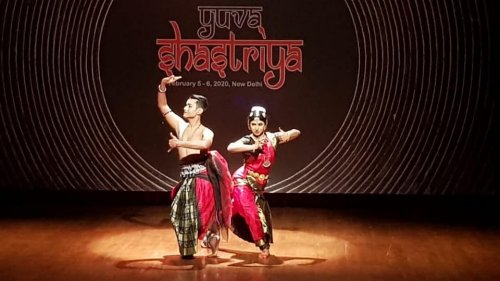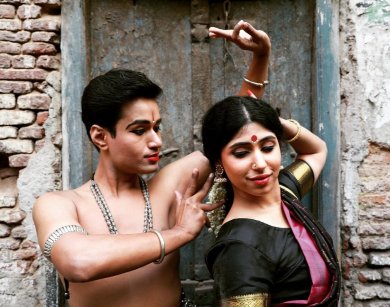
|   |

|   |
Yuva Shastriya - Jaya Rao Dayal e-mail: jayadayal@hotmail.com February 20, 2020 Yuva Shastriya, a two day festival, was organised by the Raza Foundation last week at the Triveni Kala Sangam in New Delhi. Two things that appealed to me about attending one of the concerts on Feb 6th evening: one was a beautiful capture of the two young artists who collaborated on what was called 'Shringara: tales of love and betrayal.' And the second reason was the space. More and more, I find myself appreciating a dance performance in an intimate setting. The Triveni Kala Sangam was designed by American architect Joseph Allen Stein way back in the 1950s. Springtime in Delhi with flowers in bloom indeed is a great time to watch performances.  Yuva Shastriya Tanya Saxena and Madhur Gupta, trained in Bharatanatyam and Odissi dance respectively, began their performance with the beautiful verse from the Saundarya Lahari, "Dhanuh paushpam..." It was indeed gracefully depicted. I have always wondered about the extent to which art internalises the reconciliation between the mundane and the esoteric. The almost perfect pacing reflected work on visualisation by both. The essence of the text spoke well for itself, which loosely translates as: even the weakest link wrought with all uncertainties and odds pitted against it, is made possible with the watchful glance of the goddess. This was followed by Sringara Lahari, a kriti by Lingaraja Urs. While the duet pieces were well executed, the same could not be said about the individual pieces. When I say that, it is pointing to the lack of parity of a Varnam in Bharatanatyam and an Ashtapadi in Odissi. The level of complexity differs distinctly, not just in its basic definition. Tanya's efforts shone in the central piece with mature abhinaya and nritta, where a lot of work put in was evident. Pashyati dishi dishi, the ashtapadi performed by Madhur to me was not so impactful. Mentioning that it was taught to him by his guru Sharon Lowen, who in turn learnt from the maestro Guru Kelucharan Mohapatra was of no consequence. The choreographing is only a part of a piece. It is for the individual artist to breathe life into it. I am tempted to quote what I read about Padmini Chettur's brief in her experimental film 'Varnam.' "I urge the dancers to look for the feeling of the narrative rather than expressing it narratively." They returned to the stage to conclude with a Tillana and a reprise of "dhanuh paushpam". A reprise which is used more in music fitted in here beautifully in dance too, almost like consolidating in contextualising .The duo was accompanied by a fine set of musicians. The coming together of the mardala and the mridangam was another fine collaboration. Earlier, Ashok Vajpeyi, the managing trustee of the Raza Foundation spoke to the audience about the endeavour to encourage young artistes by giving them a platform to present their work. He spoke about how it was time for the 'dhawal kesh' or the grey haired (artistes) to pass on the baton to the younger ones. This threw up a host of questions in my mind about the readiness of younger artists to take up this humongous task forward. In wake of the fact that classical dance is dependent on various other classical art forms like music, art, literature, any lacunae therein marks a regressive trend. This is where we need mentors to step in.  Madhur Gupta & Tanya Saxena A few days after the performance, I got to speak to the two artistes who presented 'Shringara.' This was an attempt to get their thoughts on the take away from this collaboration, about the challenges of pursuing dance forms that come from distinctly different cultural and vernacular regions. Both agreed upon the fact that the work required was probably three times more for a dancer from outside the culture given the detailing required, sensitisation to the music, to the text where their access is limited because of translations being so watered down.Tanya felt that working with Odissi, the biggest take away, was imbibing the quality of fluidity and lyricism. But the challenge is where it can be incorporated without compromising on the style that one is pursuing. For Madhur, this collaboration has meant immense learning because of the constant dialogue. The underlying reference has always been staying true to the art form though. Both of them felt highly indebted to the invaluable inputs given by Kamalini Dutt. Jaya Rao Dayal is trained in Bharatanatyam, and in the last decade, she has been pursuing research in Indian aesthetics. She submitted a dissertation to Jnanapravaha in Mumbai as part of a post graduate program in Indian aesthetics. |